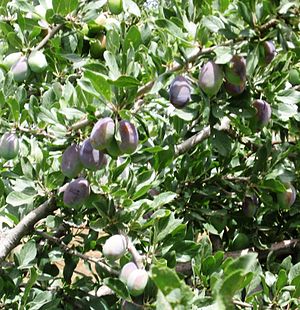- Midelt
-
Midelt Jbel Ayachi looms over the old French quarter of Midelt Location in Morocco Coordinates: 32°40′48″N 4°43′48″W / 32.68°N 4.73°WCoordinates: 32°40′48″N 4°43′48″W / 32.68°N 4.73°W Country  Morocco
MoroccoRegion Meknès-Tafilalet Elevation 4,948 ft (1,508 m) Population (2004) - Total 44,780 Time zone WET (UTC+0) - Summer (DST) WEST (UTC+1) Midelt (Arabic: ميدلت) is a town in central Morocco, in the high plains between the Middle Atlas and High Atlas mountain ranges. With an estimated population of 44,780, Midelt serves as the commercial center of a large agricultural hinterland. It is also one of Morocco's principal cities for the mining of several minerals. Coordinates: 32°40′48″N 4°43′48″W / 32.68°N 4.73°W.
Contents
Geography
Midelt is situated on the main road between Fes and Meknes to the north and Errachidia to the south. Geographically, it is situated in the high plains surrounding the Moulouya River, between the Middle and High Atlas mountain ranges.
The city's elevation is 1,508 metres (4,948 ft), making it one of the highest large towns in Morocco.
Climate
The elevation of Midelt cools the daily temperatures to make Midelt one of the most temperate of the inland towns. However, many coastal towns have milder temperatures, warmer in winter and cooler in summer.
Temperature averages, from the years 1961 to 1990, yield daily maximum/minimum temperatures for January as 12.3 / 0.6 degrees Celsius and for July as 32.6 / 16.3 degrees Celsius.[1] Snow is common in winter, and precipitation continues throughout the year at moderate levels. However, the principal water source of the region is a spring at the foot of Jbel Ayachi, 10 kilometres (6 mi) south of Midelt.
A dam moderating the flow from the spring was destroyed by a flood in early 2006 following heavy snows the previous winter, damaging the nearby village of Tattiwin.
History
Midelt grew in the first half of the 20th century around a French administrative post by the same name. Previously, villages and ksour had dotted the fertile surroundings. The French established their post to facilitate the mining of lead, gypsum, other minerals, and fossils in the nearby Ahouli and Mibladen mines and elsewhere. The development of these mines led to the construction of a railroad from Midelt to the Mediterranean coast and the electrification of Midelt in 1930. In Morocco, only Casablanca received electricity earlier.
After Moroccan independence in 1956, control reverted to the Moroccan government, which occupied the European-style buildings of the former French quarter. Midelt no longer has a regional administrative function; it has his own province but its Wilayah is seated in Meknes.
People
Midelt is a largely Berber (Amazigh) city with a sizable minority who identify themselves as Arabs. Berber residents speak the Middle Atlas language Tamazight as well as the Moroccan Arabic dialect, known as Darija. A typical resident will speak Tamazight at home but Darija in public. Educated residents also speak Modern Standard Arabic and French, which are used throughout Morocco in mass media, education, and government.
Because Midelt is a new city, almost all Mideltis can trace their roots either to one of the nearby villages or to elsewhere in Morocco. The city also lacks the sharply defined neighborhood divisions and traditional souqs of older Moroccan cities.
Very few non-natives live in Midelt. Of these, the longest established are a community of Franciscan nuns and Cistercian monks living at the Monastery of Our Lady of the Atlas in a nearby village. The nuns work with local women and girls to develop handcrafts and teach hygiene, French language, and other skills.
Economy
Midelt functions as the market for an agricultural area extending from the Moulouya River to Jbel Ayachi, bounded on the east and west by dry plains. This region is best known for apples; other produce includes walnuts, apricots, plums, pomegranates, wheat, corn, and a wide variety of garden vegetables.
Nomads and sedentary farmers from the surrounding area also raise sheep and goats for slaughter and for wool. Both of these are sold in Midelt, but largely for local consumption. Locally gathered evidence indicates that the local price of meat is inversely related to rainfall: in wet years, nomads can keep their herds alive through the summer and do not bring them to market; in dry years, animals are better sold than lost to draught.
Midelt's industrial sector is largely related to the nearby mines, of which only Mibladen continues to operate at high capacity. Lead, gypsum, and a host of lesser-known minerals are extracted for sale to industry and for household decorations.
Tourism continues to grow as an important source of revenue for Midelt. The climate attracts many visitors, mostly Moroccans from lower climes and émigrés to Europe. These support several small hotels as well as two larger establishments catering to Europeans. In addition to visitors, local handcrafts - especially carpets and blankets in the roughhewn nomadic style - are sold through cooperatives and merchants both locally and in Morocco's larger cities.
References
- ^ "Climatological Info. for Midelt, Morocco", Hong Kong Observatory, 2003, webpage: HKO-Midelt.
External links
 Meknes-Tafilalet region
Meknes-Tafilalet regionCapital: Meknes Provinces 
Cities Aghbalou Nssardane · Agourai · Aguelmouss · Ain Jemaa · Ain Karma · Ain Leuh · Ain Taoujdat · Ait Ishaq · Alnif · Amalou Ighriben · Aoufous · Arfoud · Azrou · Bouderbala · Boudnib · Boumia · El Hajeb · El Kbab · Errachidia · Goulmima · Gourrama · Had Bouhssoussen · Hadj Kaddour · Ifran · Itzer · Jorf · Kahf Nsour · Kerrouchen · Khenifra · Meknes · Mhaya · Midelt · Moulay Bouazza · Moulay Driss zarhoun · M'Rirt · Nzalat · Errich · Rissani · Sabaa Aiyoun · Sebt Jahjouh · Sidi Addi · Souk EL Had · Tighassaline · Tighza · Timahdite · Tinjdad · Tounfite · ZaidaCategories:- Populated places in the Meknès-Tafilalet Region
Wikimedia Foundation. 2010.




